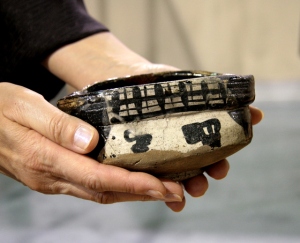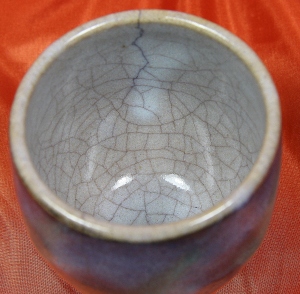What tea drinker has not had a crack develop in a favorite a teacup or teapot ? Errant cracks are generally un-appreciated, and, in fact, many serviceable tea vessels reach a premature demise once a crack appears. Who wants to risk having tea liquor spill all over their lap, laptop or the table ? If we are especially fond of these pieces we might allow them a new life as an objet d’art in the kitchen or on a bookshelf.
But some cracks do not go all the way through a piece of clay. Some cracks are only in the glaze and do not affect the functionality of the piece. Some cracks do go all the way through, but are located in an out-of-the-way place that is not problematic. We may not dream of presenting tea to a guest a cracked cup, but we may still use it ourselves.
But how many of us view this crack as a positive virtue of the teacup or tea pot ? As a part of the character of the cup or as the ‘voice of the clay’ speaking to us ?
Consider it this way. In Japan and Korea handmade pottery is highly desireable. ( Porcelain teawares have many fans, too, but porcelain is very hard, static and constant, whereas pottery is soft, dynamic and imbued with a changing nature. ) When selecting a pottery teacup or tea bowl or teapot to purchase, tea enthusiasts consider two variables which speak about the potter who made the piece:
- are the potter’s aesthetic decisions well executed ?
- is the the piece skillfully and artistically rendered ?
Some of the qualities that ceramics lovers look for in handmade pottery are:
- the shape and appearance of vessel
- the comfort and feel of the piece in the hand
- the heft or lightness of the tea bowl or teapot
- the type of clay and the texture: dark or light, soft or hard, smooth or rough
- how the glaze or absence of glaze enhances the appearance of the piece
- the influence of the type of kiln used on the surface characteristics and appearance
- the fineness and comfort of the lip ( teacup ) or the easy of pouring from the spout ( teapot )
In Japan and Korea much attention is paid to the unique characeristics of handmade pottery, and this includes all of the little variables that make a handmade piece unique. A drippy glaze, a slightly lopsided lip, a a finger mark in the glaze, etc, fit this bill. Handmade pottery has an appealing simplicity too, and often a rustic, uneven form and style. Pottery changes and ‘wears’ over time. It develops a patina and personality that adds beauty and individuality to the piece.
And pottery can develop cracks, too. Cracks that do not leak or weaken the vessel are actually held in high regard by some tea drinkers and potters. It is the voice of the clay speaking, and the clay adding some ‘self-patterning’ to the piece. No two pieces of pottery can ever be exactly the same, particularly when the clay develops a crack from use.
This is one of my most treasured teacups ( from Japan ) and the cup that I drink my green tea from every morning. The small network of fine cracks developed over the course of the first year of use and became prominent as the tea liquor seeped into the cracks. The occurance of the larger two cracks running from lip to center are a mystery to me. As far as I know, the cup has always been handled carefully. I hand wash it ( never the dishwasher for handmade pottery ), and leave it carefully to dry on the counter. No one else uses it.
The cracks simply appeared but so far have caused no problems. In truth, I like them. And I rue the day that my cup might suffer a break and the cracks will no longer be there to charm me everyday.




